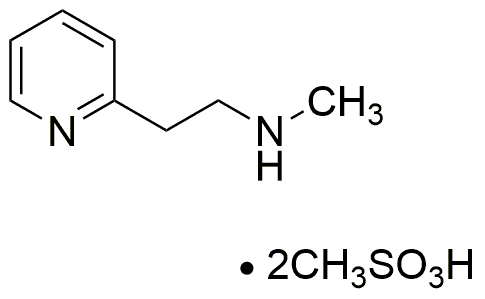Betahistine methanesulfonate is widely utilized in research focused on:
- Treatment of Vestibular Disorders: It is primarily used to alleviate symptoms of Meniere's disease and other vestibular disorders, helping patients manage vertigo and balance issues effectively.
- Pharmaceutical Development: Researchers explore its pharmacological properties to develop new formulations that enhance bioavailability and patient compliance, particularly in oral dosage forms.
- Neuroscience Research: It is studied for its potential neuroprotective effects, contributing to research on conditions such as tinnitus and other auditory processing disorders.
- Clinical Trials: The compound is frequently involved in clinical trials aimed at assessing its efficacy and safety, providing valuable data for healthcare professionals and regulatory bodies.
- Combination Therapies: It is investigated for use in combination with other medications to improve therapeutic outcomes for patients with complex conditions, offering a more holistic approach to treatment.
Información general
Propiedades
Seguridad y normativas
Aplicaciones
Betahistine methanesulfonate is widely utilized in research focused on:
- Treatment of Vestibular Disorders: It is primarily used to alleviate symptoms of Meniere's disease and other vestibular disorders, helping patients manage vertigo and balance issues effectively.
- Pharmaceutical Development: Researchers explore its pharmacological properties to develop new formulations that enhance bioavailability and patient compliance, particularly in oral dosage forms.
- Neuroscience Research: It is studied for its potential neuroprotective effects, contributing to research on conditions such as tinnitus and other auditory processing disorders.
- Clinical Trials: The compound is frequently involved in clinical trials aimed at assessing its efficacy and safety, providing valuable data for healthcare professionals and regulatory bodies.
- Combination Therapies: It is investigated for use in combination with other medications to improve therapeutic outcomes for patients with complex conditions, offering a more holistic approach to treatment.
Documentos
Hojas de datos de seguridad (HDS)
La SDS proporciona información de seguridad completa sobre la manipulación, el almacenamiento y la eliminación del producto.
Especificación del producto (PS)
La PS proporciona un desglose completo de las propiedades del producto, incluida la composición química, el estado físico, la pureza y los requisitos de almacenamiento. También detalla los rangos de calidad aceptables y las aplicaciones previstas del producto.
Certificados de análisis (COA)
Busque certificados de análisis (COA) ingresando el número de lote del producto. Los números de lote y de partida se pueden encontrar en la etiqueta de un producto después de las palabras "Lote" o "Lote".
Número de catálogo
Número de lote/lote
Certificados de origen (COO)
Este certificado de origen confirma el país en el que se fabricó el producto y también detalla los materiales y componentes utilizados en él y si se deriva de fuentes naturales, sintéticas u otras fuentes específicas. Este certificado puede ser necesario para cumplir con las normativas aduaneras, comerciales y regulatorias.
Número de catálogo
Número de lote/lote
Hojas de datos de seguridad (HDS)
La SDS proporciona información de seguridad completa sobre la manipulación, el almacenamiento y la eliminación del producto.
DownloadEspecificación del producto (PS)
La PS proporciona un desglose completo de las propiedades del producto, incluida la composición química, el estado físico, la pureza y los requisitos de almacenamiento. También detalla los rangos de calidad aceptables y las aplicaciones previstas del producto.
DownloadCertificados de análisis (COA)
Busque certificados de análisis (COA) ingresando el número de lote del producto. Los números de lote y de partida se pueden encontrar en la etiqueta de un producto después de las palabras "Lote" o "Lote".
Número de catálogo
Número de lote/lote
Certificados de origen (COO)
Este certificado de origen confirma el país en el que se fabricó el producto y también detalla los materiales y componentes utilizados en él y si se deriva de fuentes naturales, sintéticas u otras fuentes específicas. Este certificado puede ser necesario para cumplir con las normativas aduaneras, comerciales y regulatorias.


